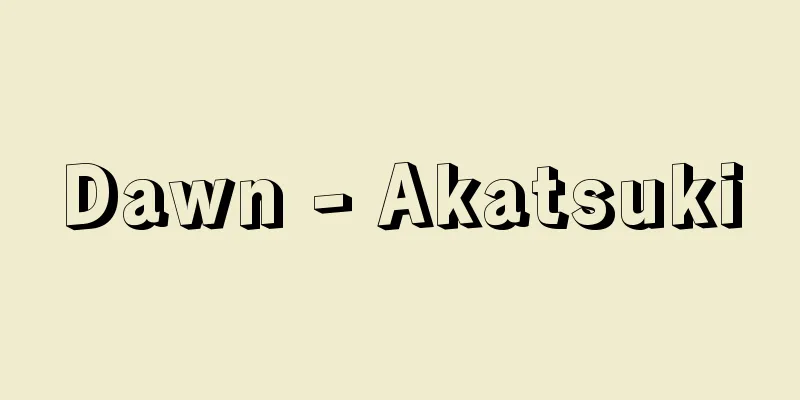Dawn - Akatsuki

|
〘Noun〙 (a variation of "akatoki")① From midnight until near dawn when it is still dark. Before dawn. Also, the time close to dawn. Currently, it refers to the time just before dawn when it is slightly light. ※Nihon Shoki (720), Nintoku 38th year, July (Maeda Honkun) "At that time, two deer were lying down beside me. As the rooster was about to crow , the stag said to the hind, "He returned deep in the morning ." ② An abbreviation of "akatsukioki (rising at dawn)." ※Makura (end of the 10th century) 119 "The sight of the akatsuki 's forehead, which he had left by his side, was extremely pitiful." ③ The name of a fragrant wood. It is classified as aloeswood . ④ The moment when something is realized. Also, the resolution or disposal of something. End of the story. *Kabuki Yowajo Ukina Yokogushi (Kirare Yoza) (1853), Act 5: “Kou Banno-san, please go to hell already. What will this dawn do?” *I Am a Cat (1905-06), Natsume Soseki, Chapter 9: “If a person like my master no longer exists as a teacher” [Essay] (1) In the ancient period, it was “akatoki”, and in the Middle Ages it became “akatsuki” and has remained to this day. Originally, it referred to the part following “yoi” and “yochu” in the three divisions of night, but since “shinonome”, which means one step before dawn, and “akebono”, which means when the sky becomes light, were created in the Middle Ages, it gradually became confused with them. (2) In the Middle Ages, "akatsuki" was used in both poetry and prose, but "akebono" was basically a literary word (often in medieval waka poetry), and "shinonome" was a poetic word. In the custom of commuter marriage, "akatsuki" was the time when the man left the woman and returned home, and there are expressions such as "akatsuki no wakari" (parting of akatsuki). On the other hand, the time when the man would come was "yoi," and there are also mature examples such as "yoi akatsuki" (yoi akatsuki). Aka-toki [dawn]Source: The Selected Edition of the Japanese Language Dictionary About the Selected Edition of the Japanese Language Dictionary Information |
|
〘名〙 (「あかとき」の変化した語)① 夜半過ぎから夜明け近くのまだ暗いころまで。未明。また、夜明けに近い時分。現在では、明け方のやや明るくなった時分をいう。※書紀(720)仁徳三八年七月(前田本訓)「時に二の鹿、傍に臥せり。鶏鳴(アカツキ)に及ばむとして牡鹿(しか)牝鹿(めか)に謂ひて曰く」※源氏(1001‐14頃)葵「あか月深くかへり給ふ」② 「あかつきおき(暁起)」の略。※枕(10C終)一一九「たてへだてゐて、うち行ひたるあかつきの額(ぬか)など、いみじうあはれなり」③ 香木の名。分類は伽羅(きゃら)。④ ある物事が実現したその時。また、物事の解決、処理。始末。※歌舞伎・与話情浮名横櫛(切られ与三)(1853)五幕「コウ伴頭さん、いいかげんに往生しなせへ。此暁(アカツキ)はどうしてくれるよ」※吾輩は猫である(1905‐06)〈夏目漱石〉九「もし主人の様な人間が教師として存在しなくなった暁には」[語誌](1)上代には「あかとき」で、中古以後「あかつき」となって今日に及ぶ。もともとは、夜を三つに分けたうちの「宵」「夜中」に続く部分をいったが、明ける一歩手前の頃をいう「しののめ」、空が薄明るくなる頃をいう「あけぼの」が、中古にできたために、次第にそれらと混同されるようになった。 (2)中古では「あかつき」は歌・散文の双方に用いられるが、「あけぼの」は基本的には文章語(中世和歌には多い)、「しののめ」は歌語である。通い婚の習俗では、「あかつき」は男が女と別れて帰る刻限であり、「あかつきの別れ」などの表現もある。一方、男が訪れるのは「よい」であり、「よいあかつき」と熟した例も見られる。 あか‐とき【暁】出典 精選版 日本国語大辞典精選版 日本国語大辞典について 情報 |
>>: Akatsuka's own knowledge - Akatsukajitoku
Recommend
The Social System
One of the major works by American sociologist T. ...
Prussian General Land Law - Prussian General Land Law (English)
The Great Code of 18th century Prussia, on a par w...
Polyxene
…mother of Hector, Paris, and Cassandra. Accordin...
Empidonax
...2 species), Myiarchus (crested flycatcher, 22 ...
Merger - Gappei
When two or more companies become one company thr...
philanthrōpia (English spelling) philanthropy
…The idea of fraternity, which became a Western...
Klein, Lawrence R.
Born: September 14, 1920 in Omaha, Nebraska [Died]...
Blue Rose - Aoibara
...SI Mamontov, a patron of the Itinerant Exhibit...
Yoshitaro Hirano
Marxist legal scholar and social activist. Born i...
Cerebral Aneurysm
[What kind of disease is it?] This is a disease in...
Jussi Björling
1911‐60 Swedish tenor. He gained musical experienc...
Rain trout - Rain
A fish of the Salmonidae family, Osteichthyes, ge...
Kinhonzen
...A military commander of the Goryeo dynasty in ...
Nasal index
…Based on the shape of the nasal bridge, noses ca...
Plasmogen
…On the other hand, among the other organelles co...

![Oonejime [town] - Oonejime](/upload/images/67cb174d1b5c9.webp)







